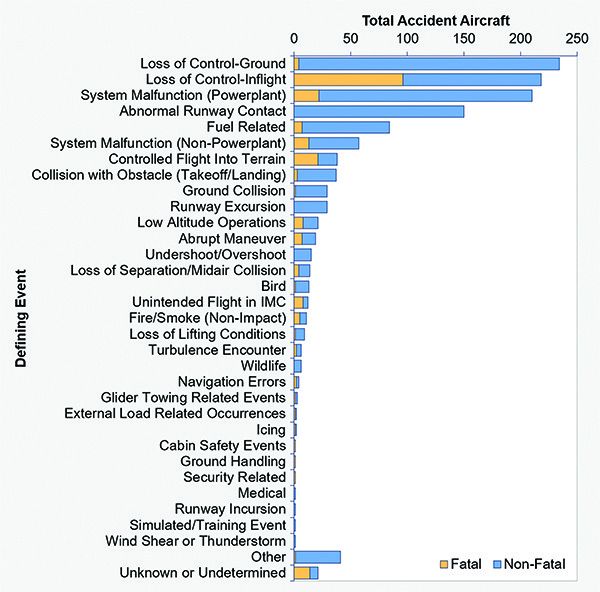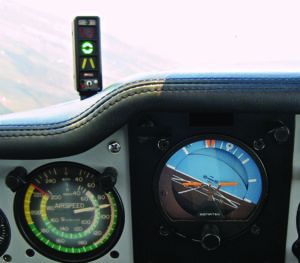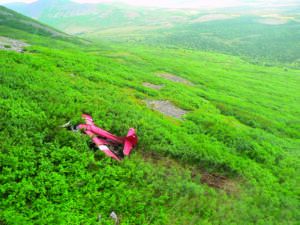
I’m going to go out on a fairly stout limb with this statement: No pilot ever plans to become an accident statistic. Instead, we all approach every flight in the firm belief it will be successful or we don’t fly. Too often, of course, events conspire against us—or we screw up—and the flight’s outcome isn’t as we planned. So…what are some of those events? What can we do to minimize the risk of becoming a statistic? One answer lies in the NTSB’s voluminous accident investigation reports and its own statistics, which help highlight how and why accidents occur.
The chart below is much more than a simple infographic. Instead, it can and should be used as a road map (flight plan?), as guidance on how most accidents occur and what we can do to avoid being involved in one. Of course, we already know most of this, thanks to our training. But it can help to discuss some of these “greatest hits” with an eye toward emphasizing what we can do to avoid creating a new entry in the NTSB’s records. While the number of categories in the chart preclude us tackling from each of them, we can take on a few of the most prevalent and avoidable defining events leading to a fatal accident.
LOSS OF CONTROL
It should come as no surprise that our old “friend” loss of control leads the list, with both in-flight and on-ground events occupying the top two spots in this dubious sweepstakes. Perhaps unsurprisingly, the chart shows we lost control on the ground a lot during 2018, but relatively few of those mishaps were fatal. I’d bet most of these events involved taildraggers, or castering nosewheels (Cirrus drivers take note!).
Not so for the in-flight flavor. Industry and government have literally spent years identifying and highlighting the various factors contributing to in-flight loss of control. According to a 2016 NTSB presentation on the topic by Senior Air Safety Investigator Paul Cox, in-flight loss of control accidents “typically involve some type of stall.” Cox lists virtually every type of stall known to fixed-wing pilots as culpable: straight-ahead, accelerated, takeoff/climb (back side of the power curve, yawing (stall/spin) and the classic overbanked turn-to-final, the skidding turn/cross-controlled stall. Unsaid in all this is that these loss-of-control events likely occurred close to the ground, and the pilot either failed to recover or didn’t have enough altitude. The events can involve all airplanes, but one other type is relegated only to twins: VMC rollover.
When it comes to mitigations, it’s way too much of a cop out to simply say that pilots need to fly the airplane. But it’s also true: According to a 2010 presentation to an American Institute of Aeronautics and Astronautics conference, by Steve Jacobson of the NASA Dryden Flight Research Center, “Human induced LOC [loss of control] causal factors are a stronger contributor to LOC accidents when compared to systems-induced and environmentally induced causal factors.” Jacobson’s conclusion comes after a study of loss of control accidents involving operations under FAR Parts 121, 135 and 91.
Perhaps necessarily—this was an aerospace industry conference, after all—potential mitigations initially focused on technology, like envelope-protection schemes for jet transports plus angle-of-attack (AoA) indicators for smaller aircraft. As Jacobson noted, “Avoidance and detection mitigations should be higher priority than recovery based mitigations but…[r]ecovery-based mitigations are important for coverage of ‘breaking the chain’ of events.” He added: “Prevention and recovery training may have a nearer term impact than technology based solutions” and, “New technologies and NextGen operations may introduce new and unforeseen LOC hazards.”
Lacking envelope-protection technology—good luck adapting that to the Super Cub out looking for Alaskan moose—the bottom line here is it’s up to the pilot to avoid losing control and to regain it when it’s lost. The sidebar above has some additional points.

There are three basic categories of factors leading to loss of control: systems-induced, environmental and human. The Air France Flight 447 tragedy, in which ice crystals plugged a pitot tube, causing the Airbus A330’s fly-by-wire systems to disengage, leaving the crew with a situation they didn’t understand and couldn’t fix, combines elements of all three.
For the typical personal airplane, new autopilot technology can help, along with installation and informed use of angle-of-attack indicators. The environmental factors to avoid include airframe icing, thunderstorms, wind shear and reduced visibility, according to the presentation by NTSB Senior Air Safety Investigator Paul Cox. He also boiled down the human factor mitigations:
Be honest with yourself about your knowledge of stalls, and your ability to anticipate and react to them.
- Understand and maintain currency in the equipment and airplanes you operate.
- Maximize training opportunities.
- Thoroughly prepare for the environments in which you’ll be flying.
- Anticipate, manage and minimize distractions.
- Increase situational awareness, including through devices such as angle-of-attack indicators.
SYSTEM.ENGINE FAILURES
In the mid-2010s, I had the unique opportunity to participate in a months-long effort of the General Aviation Joint Steering Committee, the FAA, airframe manufacturers, user groups, associations and other parties in developing ways to mitigate the threat of engine failures as a fatal accident cause. Recommendations from that effort are still emerging, but I came away with the firm belief that many (most?) engine failures are not mechanical in nature but pilot-related, instead.
That’s not to say sometimes things just break for no apparent reason. But more often than anyone wants to admit, it appears carburetor ice—which conveniently disappears by the time investigators arrive—is an unidentified co-conspirator. I’d also lump in fuel mismanagement not categorized elsewhere and just plain old failure to properly operate the engine. All that said, it’s of little comfort when an engine quits and you didn’t do anything wrong. While the same is true for system failures, they’re much less frequent here and less lethal.
None of which really matters when you can’t continue the flight and need a decent landing area. Mitigations for engine/systems failures aren’t as sexy or tangible as for other defining events, but they are obvious. Perhaps the most bang for the buck is a strict maintenance regimen: Don’t skimp on inspections, oil analysis or manufacturer’s recommended operating procedures and lubricants. Operate the engine(s) as the expensive, tempermental assets containing a bunch of moving parts keeping you in the air that they are.
When it comes to maintenance decisions, err on the side of caution—hoping that soft cylinder will make it to TBO isn’t a safety-oriented strategy. Plan your flights to avoid terrain inhospitable to emergency landings, and fly the risky ones in daylight. Use the new tools available on EFBs and in your panel to ensure you’re always close to land or an adequate airport.
And practice engine-out procedures at every opportunity. When your sole engine quits is not the time to look up the best-glide speed or the off-airport landing checklist. If you fly a twin, regularly get some dual on one-engine inoperative flight, shoot some approaches with one turning and one burning, and make full-stop landings from them. Remember that the likelihood of a typical light twin successfully going around from a balked landing or missed approach is slim.

Some of the recommendations from the NTSB’s Safety Alert on avoiding CFIT in VFR include:
- In remote areas, especially in overcast or moonless conditions, darkness may render visual avoidance of high terrain nearly impossible.
- When receiving radar services, do not depend on ATC to warn you of terrain hazards. Controllers may not always recognize a VFR aircraft is dangerously close to terrain.
- When issued a heading with an instruction to “maintain VFR,” the heading may not provide terrain clearance. Ask ATC to keep you at/above IFR minimum vectoring altitudes.
- ATC can provide limited prediction and warning of terrain hazards, but the warnings normally are suppressed for VFR aircraft. Controllers can activate it for VFR flights upon request, but it may produce numerous false alarms when operating below minimum instrument altitudes.
- For improved night vision, the FAA recommends the use of supplemental oxygen for flights above 5000 feet msl.
CFIT
Lacking a powerplant-related emergency or some kind of altimetry failure, controlled flight into terrain seems to me to be one of the most preventable fatal accident types. But it continues to figure prominently in the NTSB’s annual lists of accident-defining events. The sidebar below includes some tips from NTSB Safety Alert SA-013, “Controlled Flight Into Terrain in Visual Conditions,” revised in 2015.
Some additional recommendations, also from the NTSB, focus on applying some IFR procedures to nighttime VFR operations. For example, when planning a nighttime VFR flight, follow IFR obstacle departure procedures or published standard departures. If none exist, review the published IFR altitudes and/or approach/missed-approach procedures for your departure airport to determine where the high terrain is and what altitudes are necessary to clear them. The minimum safe altitudes on an approach procedure’s plan view are there for a reason. All this stuff likely is in your EFB application. Obtain ATC assistance, if it’s available.
Before a night flight away from your home airport, review the sectional chart for the published maximum elevation figure (MEF), the bold blue values in each quadrant. Even better, just use the minimum altitudes published on the low altitude en route chart. If that’s not doable for whatever reason, choose a cruising altitude 2000 feet above the MEF in mountainous areas and 1000 feet above ground elsewhere. Remember that strong winds over even low ridges can result in downdrafts exceeding your airplane’s ability to climb. Use sectionals or other tools, like an EFB’s profile view, to ensure you clear terrain and obstructions along your route.
FUEL-RELATED
Fuel starvation and mismanagement have well-understood roots: Either the flight ends because there’s no fuel aboard or there’s fuel aboard but it can’t get to the engine(s). Although there certainly are scenarios where mechanical faults or other events typically beyond anyone’s control are culpable, the outcome is the pilot’s fault in the vast majority of these accidents.
Start with a firm understanding of your specific airplane’s fuel system, which may vary considerably from the way it left the factory. Be aware that some engine/airframe combinations return excess fuel from the engine to a tank other than the one selected—the system could be pumping fuel overboard. If the airplane has aftermarket auxiliary tanks, they may be approved for use only in straight-and-level flight, not for takeoffs or landings.
Remember that fuel gauges in typical personal airplanes are…aspirational. In this modern age, it’s foolhardy to base your fuel burn estimates on analog engine power instruments and a stop watch. Install and learn how to use a fuel-flow meter, many of which can be linked to a GPS—even a portable unit—to provide a wealth of information like time/distance to empty, fuel remaining at destination and even miles per gallon (the latter of which can be discouraging).
Finally, if there’s any chance you’ll not arrive at your destination with adequate fuel aboard, stop and get some. It’s Aviation 101. If you find yourself in a bind, use the words “minimum fuel” with ATC and you’ll likely receive priority handling, even if VFR. It might be considered insensitive to say this, but there’s really no excuse for running out of gas.
With all that as preamble, it’s important to remember that the NTSB’s list of defining events doesn’t include everything. Many accidents are unique, and have more than one root cause.
Jeb Burnside is this magazine’s editor-in-chief. He’s an airline transport pilot who owns a Beechcraft Debonair, plus the expensive half of an Aeronca 7CCM Champ.




Jeb:
I’ve enjoyed ?!! (NOT) 4 loss of power events (carb ice in IMC – lost 7000′ while about 8000 AGL in SE rental before engine regained power still in IMC; mag failure at 3500 AGL abt 45 hrs after major OH – landed at nearby airport under power; spark plug discentigrated at night at around 4500′ MSL 3500’AGL over southern border – landed at nearby airport in Mexico with minimal power; Engine siezed at 5500 MSL 4500 AGL at night 10 hrs after 100 hr where metal in oil NOT NOTED IN SQWAUK sheets of corporate aircraft – Landed at night on major divided hwy. I have friends who have had engine failures – none from fuel exhaustion. All mechanical. Very few resulted in NTSB accidents. My take is pilots generally manage their engine emergencies well. Maintenance issues in owned, rental and corporate aircraft… not so good. For all intentsmaintenance is often a ‘black box’ beneath the cowl.